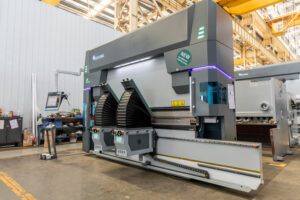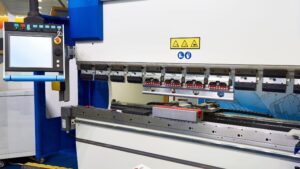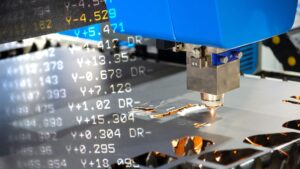Laser cutting is a technique that utilizes high-power lasers to cut through various materials, including metal. It’s known for its high precision, speed, and versatility, and is a preferred method for numerous industries. This guide aims to provide a comprehensive look at laser cutting metals, focusing on its process, capabilities, applications, and various parameters.Metal Laser Cutting
Can metal be cut with a laser?
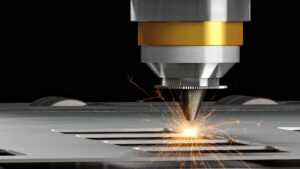
Yes, metal can be cut with a laser. In fact, laser cutting is one of the most efficient methods for processing various types of metals. It’s capable of delivering precise cuts, complex shapes, and high-quality edges, making it an excellent choice for diverse industries.
How does metal laser cutting work?
Metal laser cutting involves a highly concentrated laser beam that’s directed onto the metal surface. The heat from the laser melts or vaporizes the metal, producing a clean, accurate cut. Here are the main stages of metal laser cutting:
- Designing the cutting pattern: Before the actual cutting, the design or pattern is created in CAD or other graphic software.
- Configuring the laser cutter: The operator sets the power, speed, and focus of the laser according to the type and thickness of the metal.
- Cutting the metal: The laser cutter follows the design pattern, cutting through the metal with high precision.
- Cooling and post-processing: After cutting, the metal parts are cooled and any residual debris is removed. Additional post-processing steps may include deburring or applying protective coatings.
What are the different types of laser cutters used for metal cutting?
There are two main types of laser cutters used for metal cutting: Fiber laser cutters and CO2 laser cutters. Each comes with its unique strengths and drawbacks.
Fiber laser cutters
Fiber lasers are known for producing narrower beams, thus providing about quadruple the effective power for the same laser output energy. They operate faster and with greater precision than their CO2 counterparts. Fiber laser cutting has lower operating costs due to electrical efficiency and solid-state construction, but they require more nitrogen shielding gas in the cutting process. They are suitable for high-precision cuts on thinner metal parts.
CO2 laser cutters
CO2 laser cutters deliver a wider cutter beam width and are capable of higher device power. They are better suited for lower-precision cuts on thicker parts. The initial cost of equipment (CAPEX) for CO2 lasers is lower than for fiber lasers, but operating costs (OPEX) are higher per length of cut.
What are the main parts of a metal laser cutter?
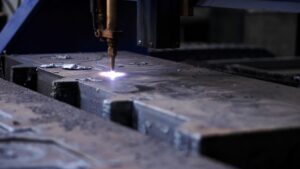
A metal laser cutter is composed of several key components:
- Laser resonator: This is where the laser beam is generated.
- Cutting head: This component houses the focusing lens that directs the laser beam onto the metal surface.
- CNC controller: The computer numerical control (CNC) system controls the machine’s movements and operations based on the design inputs.
- Gas delivery system: This system delivers assist gas to the cutting head to help eject molten metal and minimize oxidation.
- Chiller: This part cools the machine components to prevent overheating during operation.
What are the main parameters of metal laser cutting process?
When cutting metal with a laser, several parameters must be carefully managed to achieve the desired results:
- Laser power: This refers to the amount of energy that the laser can deliver, measured in watts (W) or kilowatts (kW).
- Cutting speed: This is the speed at which the laser cutter moves across the material. It directly affects the cut quality and efficiency.
- Pulse frequency: This is the number of laser pulses per second. It can affect the cut quality, speed, and the overall heat affected zone (HAZ).
- Focus spot size: This is the diameter of the laser beam at its focal point. Smaller spot sizes result in narrower cuts and higher cut quality.
- Assist gas pressure: The assist gas helps eject molten material and minimize oxidation. Its pressure must be correctly set depending on the type and thickness of the material.
What are the cutting tolerances for metal laser cutting?
The typical laser cutting tolerances for metals are:
- For thin sheet metal (up to 1mm): +/- 0.1mm to +/- 0.2mm
- For medium thickness sheet metal (1mm to 5mm): +/- 0.2mm to +/- 0.5mm
- For thicker materials (over 5mm): +/- 0.5mm to +/- 1.0mm
What is the thickest metal that can be laser cut?
The thickness of metal that can be cut with a laser depends on the type of laser and its power. Generally, a laser can cut steel up to 1 inch (25.4mm) thick, stainless steel up to 0.75 inches (19.05mm), and aluminum up to 0.5 inches (12.7mm).
What are metal types suitable for laser cutting?
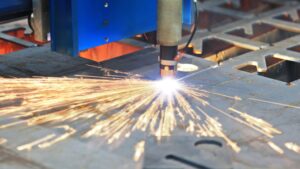
Different types of metals have unique properties that make them suitable for laser cutting. Here’s a brief rundown of each of these metals and their physical and chemical properties:
Mild Steel (Carbon Steel)
Mild steel, also known as carbon steel, is a popular choice for laser cutting. It’s affordable, durable, and offers excellent weldability. With carbon content up to 0.3%, it’s not as brittle as higher-carbon steels.
- Melting point: 2,600 to 2,800 degrees Fahrenheit
- Tensile strength: 370-500 MPa
- Specific gravity: 7.85
Stainless Steel
Stainless steel is a corrosion-resistant alloy that’s ideal for a wide range of laser cutting stainless steel applications. It offers good strength and excellent resistance to oxidation.
- Melting point: 2,550 to 2,750 degrees Fahrenheit
- Tensile strength: 515 MPa
- Specific gravity: 7.93
Aluminum
Aluminum is a lightweight, soft, and ductile metal with excellent corrosion resistance thus making aluminum laser cutting ideal for a range of industrial applications.
- Melting point: 1,220 degrees Fahrenheit
- Tensile strength: 90-140 MPa
- Specific gravity: 2.70
Brass
Brass is an alloy of copper and zinc. It’s easy to machine, has good corrosion resistance, and is excellent for decorative purposes.
- Melting point: 1,650 to 1,720 degrees Fahrenheit
- Tensile strength: 345-470 MPa
- Specific gravity: 8.4-8.73
Copper
Copper has excellent thermal and electrical conductivity. It is tough, ductile, and can be readily welded and soldered.
- Melting point: 1,984 degrees Fahrenheit
- Tensile strength: 210-360 MPa
- Specific gravity: 8.96
Galvanized Steel
Galvanized steel is steel that has been coated with a layer of zinc to improve its corrosion resistance.
- Melting point: 2,600 to 2,800 degrees Fahrenheit
- Tensile strength: 330-505 MPa
- Specific gravity: 7.85
Titanium
Titanium is known for its strength, lightness, and corrosion resistance. It’s one of the most difficult metals to cut, but laser cutting can handle it efficiently.
- Melting point: 3,034 degrees Fahrenheit
- Tensile strength: 240-370 MPa
- Specific gravity: 4.506
Nickel Alloys
Nickel alloys are resistant to corrosion and can maintain their structural integrity at high temperatures, making them ideal for use in harsh environments.
- Melting point: Varies by alloy
- Tensile strength: Varies by alloy
- Specific gravity: Varies by alloy
Silver
Silver is a soft, white, lustrous metal that possesses the highest electrical and thermal conductivity of all metals.
- Melting point: 1,762 degrees Fahrenheit
- Tensile strength: 170 MPa
- Specific gravity: 10.49
Gold
Gold is a dense, soft, shiny metal that’s the most malleable and ductile of all known metals.
- Melting point: 1,948 degrees Fahrenheit
- Tensile strength: 120 MPa
- Specific gravity: 19.32
Platinum
Platinum is a dense, malleable, ductile, highly unreactive, precious metal with a silvery-white color.
- Melting point: 3,215 degrees Fahrenheit
- Tensile strength: 125-240 MPa
- Specific gravity: 21.45
Zinc
Zinc is a bluish-white, lustrous, diamagnetic metal. It’s somewhat less dense than iron and has a hexagonal crystal structure.
- Melting point: 787.15 degrees Fahrenheit
- Tensile strength: 110-200 MPa
- Specific gravity: 7.14
Tin
Tin is a malleable, ductile, highly crystalline, silvery-white metal. Its main use is to prevent corrosion.
- Melting point: 449.47 degrees Fahrenheit
- Tensile strength: 9-14 MPa
- Specific gravity: 7.265
Lead
Lead is a heavy metal that is denser than most common materials. It’s soft and malleable, and has a relatively low melting point.
- Melting point: 621.43 degrees Fahrenheit
- Tensile strength: 17 MPa
- Specific gravity: 11.34
Inconel
Inconel is a family of austenitic nickel-chromium-based superalloys. It’s resistant to oxidation and corrosion and performs well at high temperatures.
- Melting point: 2,350 to 2,500 degrees Fahrenheit
- Tensile strength: 690-965 MPa
- Specific gravity: 8.2
What is the best metal for laser cutting?
The best metal for laser cutting depends on the specific application and requirements. However, mild steel, stainless steel, and aluminum are among the most commonly used due to their excellent machinability and compatibility with laser cutting.
What are the advantages of using laser cutting to cut metals?
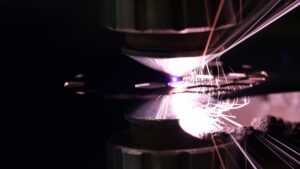
Here are some of the key advantages of using laser cutting to cut metals:
- Speed: Laser cutting is much faster than traditional cutting methods.
- Accuracy: The process offers high precision and accuracy.
- Low cost: Laser cutting is cost-effective, especially for complex designs and large volumes.
- Cut any metal: With the right power, a laser cutter can cut almost any type of metal.
- Clean cuts: The laser cutting process results in clean, smooth cuts with minimal burring.
- Versatility: It can be used for cutting complex shapes and designs.
- No contact: As a non-contact process, it minimizes damage to the target material.
- Automation: Laser cutting can be fully automated for increased productivity and consistency.
What are the industries that utilize laser cutting for metal?
Laser cutting is used in a variety of industries. Here are a few examples:
- Automotive: For producing parts such as engine components, body parts, and interior components.
- Aerospace: For cutting lightweight, high-strength parts for aircraft and spacecraft.
- Manufacturing: For producing parts for a wide range of products and machinery.
- Electronics: For cutting parts for electronic devices and circuit boards.
- Construction: For creating parts for construction equipment and building materials.
- Medical: For creating surgical instruments and medical devices.
What Are Important Factors to Consider When Laser Cutting Metal?
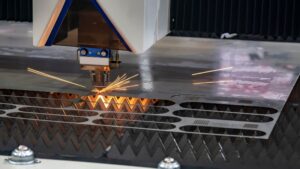
When laser cutting metal, it’s important to take into consideration a few key factors:
- Material Type and Thickness: The type of metal and its thickness will significantly impact the power requirements, cutting speed, and gas pressures needed for successful laser cutting. Different materials will respond differently to the laser, which can influence the quality of the cut.
- Laser Power and Type: Whether it’s a CO2 laser or a fiber laser, the power and type of laser can affect cutting speeds, cut quality, and the thickness of the material that can be cut. High power lasers are typically needed for thicker materials.
- Cutting Speeds: Faster cutting speeds may increase productivity, but could also produce more heat that might affect cut quality, edge smoothness, and the need for post processing.
- Assist Gas: The use of different assist gases, such as oxygen or nitrogen, can impact the cut quality and speed. They also play a role in heat management and evacuating melted material during the cutting process.
- Design Complexity: The complexity of the design will affect the cutting path and time, as well as the need for any secondary operations like bending or deburring.
Common mistakes to avoid include:
- Not accounting for the kerf (the width of the cut made by the laser) in the design which can lead to inaccuracies in the finished product.
- Not testing and adjusting parameters (like power, speed, and assist gas pressure) when switching between different types of metals or thicknesses.
- Ignoring regular machine maintenance, such as cleaning the lens and ensuring proper alignment, which can negatively impact cut quality and machine longevity.
How to Laser Cut Metals?
Laser cutting metals involves several steps:
- Designing the Parts: Design your parts using CAD software, keeping in mind the thickness of the material and the laser’s capabilities.
- Setting Up the Machine: This involves choosing the right power settings, speed, and assist gas pressure based on the metal type and thickness.
- Loading the Material: Securely place the sheet metal onto the cutting bed of the machine.
- Running the Program: After everything is set up, run the program and let the laser cutter do the work. Always monitor the process for any potential issues.
- Unloading and Post Processing: Once the cutting is complete, remove the parts from the machine. Inspect the edges and, if necessary, perform any post-processing such as deburring.
What are the Most Important Preparations for Metal Laser Cutting?
Before beginning the laser cutting process, there are a few key preparations:
- Designing for Laser Cutting: Ensure your designs are compatible with the capabilities of the laser cutter, taking into consideration the kerf and any potential unsupported areas.
- Material Preparation: Clean the surface of the metal to remove any dust, grease, or rust which could interfere with the laser beam.
- Machine Calibration: Perform routine maintenance on your laser cutter, such as cleaning the lenses and mirrors, and ensure the machine is correctly calibrated for the material you are using.
- Safety Preparations: Always wear the appropriate safety gear, ensure the workspace is well-ventilated, and have fire safety equipment available.
Safety Tips When Metal Laser Cutting
- Wear the appropriate safety gear, such as goggles, gloves, and fire-resistant clothing.
- Ensure the workspace is well-ventilated to remove any fumes produced during cutting.
- Regularly maintain and inspect your laser cutter to prevent malfunctions that could lead to accidents.
- Always have fire safety equipment nearby as laser cutting can produce sparks.
- Don’t leave the machine unattended while it is running.
Design Tips for Metal Laser Cutting
- Design for the material’s thickness, taking into consideration the laser’s kerf.
- Avoid complex designs that could lead to overheating or distort the material.
- Account for the possibility of heat distortion by leaving sufficient space between cuts.
- Make sure that any ‘islands’ in the design are properly supported.
Is laser cutting metal expensive?
Laser cutting metal is a precise and versatile method of shaping sheets of metal, but the cost can vary greatly depending on the specific needs of a project. Several factors influence the price including the type of metal, its thickness, the complexity of the cut, and the type of laser cutter used.
On average, laser cutting services can range from $1 to $1.50 per minute of cutting time for materials with a thickness of 1-2 mm. Thus, the cost for a single cut could range from a few dollars for simple cuts to several hundred dollars for complex, precision cuts on thicker materials. It’s essential to remember that these costs can escalate quickly for larger projects or more complex cuts. However, when factoring in the precision and versatility that laser cutting offers, many find it to be a worthwhile investment.
Keep in mind, these are just the service costs. If you’re considering purchasing a laser cutter, the upfront costs can be much higher.
How much is a laser cutter for metal?
The cost of a laser cutter for metal can vary widely, depending on the type of laser, the power of the machine, and its capabilities. The price of a fiber laser that can cut steel ranges from $30,000 to $600,000, while the price of a CO2 laser with steel-cutting capabilities ranges from $10,000 to $200,000.
Entry-level metal laser cutters can start at around $10,000 to $20,000, but these may have limited power and cutting capabilities. These options are often suited for hobbyists or small businesses that don’t need to cut thick metals frequently.
For more industrial-grade metal laser cutters with higher power and precision, the prices can range from $30,000 to several hundred thousand dollars. These machines are built for heavy-duty use and can handle larger volumes of metal with greater thickness.
Lastly, large, high-powered industrial metal laser cutters used in heavy-duty applications can cost even more, going into the millions. These machines are typically used in large manufacturing or industrial settings where high volume and precision are paramount.
How fast can a laser cutter cut metal?
The speed of a laser cutter can vary greatly depending on a number of factors including the type of laser (CO2, fiber, etc.), the power of the laser, the type and thickness of the metal, and the complexity of the cut.
For thin sheet metals (up to 1-2mm), laser cutting speeds can range from 100 inches per minute (IPM) to 1000 IPM. Thicker materials (e.g., 6mm and above) might have cutting speeds in the range of 10 IPM to 200 IPM.
It’s crucial to note that the speed of the laser cutter affects the cutting efficiency, but it’s also important to balance speed with the required precision and edge quality. Higher cutting speeds might result in increased heat and potential for burrs or rough edges, while slower speeds can offer better control and smoother cuts.
Manufacturers often optimize cutting parameters to achieve the best balance between speed and cut quality for a specific material and thickness, with various assist gases (e.g., nitrogen, oxygen) being used to help achieve these optimal conditions.
Which are the best metal laser cutting machines?
There are many excellent laser cutting machines on the market, but choosing the right one depends on your specific needs. The ideal laser cutter for metal should have:
- High cutting speed and efficiency
- Excellent precision and cutting quality
- Good repeatability and stability
- High power for cutting thicker materials
- User-friendly software and controls
- Good service and support from the manufacturer
One highly-regarded brand in the laser cutting industry is Accurl, а Chinese press brake and laser cutter manufacturer, known for its metal laser cutters.
- Smart 1kW to 3kW Fiber Laser Machines: These machines are engineered to be incredibly fast and flexible. The ACCURL Smart small laser cutting machine is ideal for ultra-high-speed cutting of thin sheet metal parts and similar materials. They are designed to cut a wide range of ferrous and non-ferrous metals while increasing productivity and reducing operating costs.
- SmartLINE 2kW to 4kW Fiber Laser Machines: The ACCURL® SmartLINE is packed with easy-to-use features. It is a compact, versatile, and productive 2D laser cutting machine that delivers undisputed efficiency and superior quality results. Suitable for a wide range of materials used in metal fabrication, including highly-reflective metals and thick mild steel. Optional axis for round, square, and rectangular tubes available.
- MasterLINE 6kW to 15kW Fiber Laser Machines: ACCURL® MasterLINE machines are the most complete, compact, and configurable sheet metal laser cutter systems on the market, designed to evolve with your needs. MasterLINE fiber lasers are suitable for a wide range of materials, including highly-reflective metals and high thickness mild steel. They also have optional Axis for round, square, and rectangular tubes.
What are alternative technologies and processes used for laser cutting metal?

There are several alternative processes used for cutting metal, including:
- Plasma Cutting: This uses a high-velocity jet of ionized gas to cut through electrically conductive materials. Plasma cutting is typically faster than laser cutting, but it may not be as precise or leave as clean of an edge.
- Waterjet Cutting: This method uses a high-pressure jet of water, sometimes with an added abrasive substance, to cut through materials. Waterjet cutting can handle thicker materials than laser cutting and does not heat up the material, but it can be slower and less precise.
- Mechanical Cutting (e.g., sawing, shearing, milling): These traditional methods use a physical tool to cut the metal. While often less expensive than laser cutting, these methods typically do not offer the same level of precision and may require more post-processing to achieve a clean edge.
Compared to these alternatives, laser cutting provides a balance of speed, precision, and versatility. While other methods may be better suited to specific tasks or materials, laser cutting offers a broad range of capabilities that make it a versatile tool in metal fabrication.
Conclusion
Laser cutting is a versatile, precise, and efficient method for cutting metal. While the initial cost of laser cutting machines can be high, the speed and precision they offer can lead to increased productivity and reduced costs over time. With a variety of machines on the market, there is likely a laser cutter to fit any need or budget.
FAQs
1. What gas is used for laser cutting metal?
In laser cutting, assist gases such as oxygen, nitrogen, and air are commonly used. Oxygen is often used to cut ferrous metals due to its reactivity with the metal, which helps to speed up the cutting process. Nitrogen and air are used when a high-quality, oxide-free edge is needed, as they do not react with the cut surface.
2. Can a 100w CO2 laser cut metal?
A 100W CO2 laser is typically not powerful enough to cut through metal, especially if the metal is thicker. These lasers are often used for engraving or cutting non-metal materials like wood, acrylic, or leather.


